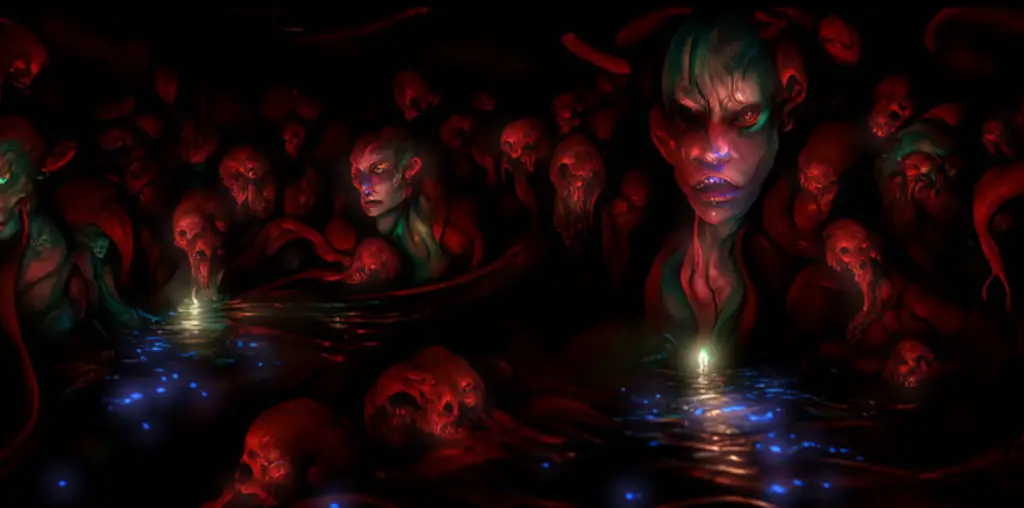
This DVD is a follow up to Lowave’s first collection of experimental films curated by the Collectif Jeune Cinema. They are continuing to do an excellent job of making exciting new films available to the public in a well-produced package. Once again, the members of the Collectif have shown that they have a special ability to locate films which are expressive, compelling, and of high artistic quality. As in the first volume, this DVD comes with a helpful booklet, biographies and filmographies of the artists, and subtitles.
In “K Désert,” Frédérique Devaux uses techniques which are now standard and familiar in experimental work: directly painting and scratching on Super 8 film, and refilming in various ways onto 16mm. The original footage (difficult to discern) seems to be of some kind of traditional (Algerian) celebration in the desert. Edited in a jerky, lively rhythm, these images are repainted and layered over each other. We see as much of the film’s optical sound track and sprocket holes as we do of the frames themselves. The sound, following a similar logic, takes traditional music and creates a looped, lively cacophony. The result, which creates a sustained texture rather than a developing composition, is energetic and exciting to the eye as well as to the ear; as if the celebratory mood of the figures was being transmitted to the material elements of the film itself.
Mauro Santini’s haunting video “Da Qui, Sopra il Mare” is a mesmerizing and beautiful montage of images around a seaside town. All the images are softened by a radical blur, suggesting not only that the video is a memory piece, but that some of the memories are intensely painful. The excellent sound score, a collage of electronic textures with ambient sounds such as trains and birds, adds to the mood of nostalgia tinged with anxiety. Mostly, the images are of empty rooms, but the powerful music makes these rooms seem like the sites of past dramas, so that the mere sight of the rooms is enough to conjure up ghosts. We also see the lone figure of a woman, gazing out of a window or drifting down a hallway. (All of the footage is in slow motion.) We see a few fragments of a happy boating party and a pleasant meal. Santini has a masterful ability to blend images and sounds to create a dreamlike experience.
Shiho Hano’s 6 minute 16mm study “Lily in the Glass” is a theme and variations on a remarkably limited set of objects: a glass, a white lily, a wooden bench, and a letter. The film begins with a black frame, lit briefly by flashes, as if to remind us that only through light do we see anything at all. These flashes grow longer, showing us the bench and the flower. The film examines various permutations of the compositional possibilities containing these elements, and of different camera angles and heights. A letter is placed on the bench by a hand, later it is picked up. Near the end of the film there are a few surprising new objects, including a reflecting globe in which the glass and the lily can be seen. The ambient, subliminal sound score is of low and distant noise. This highly formalized set of variations is suffused from beginning to end with a sense of a powerful light, creating different spaces in which a variety of relationships may be contemplated.
Dominik Lange’s “Deperdition Lointaine” may be set on a sunny day in the countryside, but it is no pastoral vision. The camera takes us on a journey down hedge-lined paths and past an abandoned truck, through a ruined-looking landscape. The incredibly agitated movements of the camera, which often turns upside-down, is compounded by the fast intercutting of the editing. The sound track, an electronic score, creates a growing atmosphere of panic and hysteria, making the film a nightmarish vision. The motion-induced blur of the images only increases throughout the film, which climaxes inside of an old church, where the shaking images of the stained-glass windows become streaks of light. Lange effectively combines sound, motion, and image to create a harrowing journey of disassociation and terror.
“Artémis” is Valérie Morignat’s “digital improvisation” to excerpts from orchestral and electronic works by Costin Miereanu. Miereanu’s work generally creates a wash of sound, out of which notes appear like scintillating points of light, and Morignat creates a video well suited to the music. There are two layers of images: in the front, a texture is derived from ocean waves, shown at a slow frame rate and stylized into stars of white light over black, a nearly abstract rendition. Behind this layer, we see the twisting form of a nude woman, on whom some images are projected in red. When the music reaches an excited climax at the video’s center, the figure of the woman becomes dominant, and her quickly twisting movements along with the rapid intercutting of images creates an agitated sense, almost of the meaty pulsation of life being born out of the primordial soup. At the video’s end, the images of water return, this time contained within the woman’s body. The video certainly evokes the mythological resonances suggested by the title, but it is mainly an experience of gorgeous images and lush music, enhanced by Morignat’s consummate skill at manipulating digital video.
In Olivier Fouchard’s silent “Flamenc’o,” brief flares of light illuminate still images, in grainy black and white, of a bare, industrial room. (It looks like a basement.) As more of these still images are run in sequence they begin to create the illusion of normal film motion, but the frame rate is always unsteady and the images are always fragments, so we get the sensation of a series of stills which are always threatening to become a movie. In this room, two dancers play with illuminating the space and illuminating each other with bright lights. The motion is too fragmented to be able to tell much about the dancing itself, but it seems to move from a postmodernist style to traditional ballroom couple dancing. “Flamenc’o” crosses the play of light with the play of bodies in space.
In his haunting film “Perhaps/We,” Canadian artist Solomon Nagler explicitly announces at the outset that the film will take place in a disembodied dream world: “I float above the world in my sleep, in my dreams…” In this beautiful collage of hand processed, painted and tinted film fragments, we repeatedly find ourselves in a painter’s studio, in which the artist is asleep on a couch. His ghost image rises up, even as his sleeping body remains on the couch. The artist seems to be painting Hebrew letters (which also serve as numbers introducing the sections of the film in intertitles). We see fragmentary images of a Jewish cemetery in Poland, of prayer books, a handsome young man dressed as an angel, a naked female model. The soundtrack blends together mournful music, a scratchy recording of a cantor at prayer, a train dispatcher, bird sounds. Nagler uses familiar experimental film techniques to create a shifting dreamworld of clouded memories of genocide and of a vanished world, where the artist holds the key to re-establishing a connection to the past.
Canadian/Argentinian filmmaker Ruben Guzman pays homage to Argentinian rail lines in his grainy black and white film, “F.I.R.T. 119.” This film derives tremendous power from the tour de force musical score by Adriana de los Santos, in which she extracts sounds from a prepared piano which have the energy and rhythm of trains, and sometimes almost the exact same tonalities. Guzman shot footage directly from the front of the train, from the side windows, on the roof, and generally includes sped-up footage which exaggerates the speed and the crazy vibrations of the train’s motion. Reminiscent of Soviet film which celebrated the proletariat and industry, de los Santos and Guzman have created a film poem which reignites the excitement that industrial rail must have generated when it was new.

